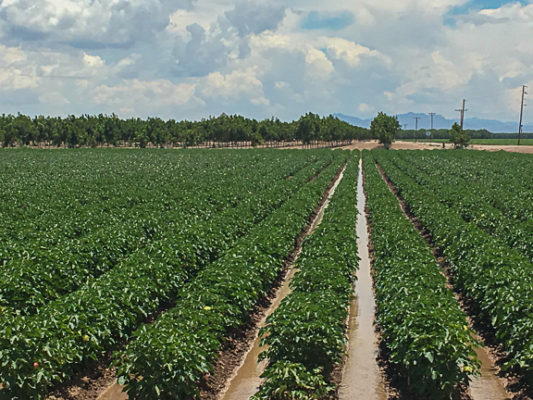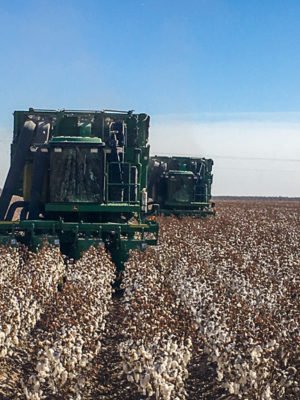Many Borderlanders may not realize that El Paso County’s Lower Valley is one of the nation’s largest cotton producers. But the valley’s historical farming communities like San Elizario, Texas, face a struggle to continue working the land.
“Cotton farming in San Elizario can be traced back to the early 19th century in the El Paso Lower Valley,” says Orlando Flores, of Texas A&M Agrilife Extension Services. “Originally the county produced grapes, the Mission Grapes, but died off due to a fungus. After that, cotton was introduced into the valley.”

Cotton fields in Clint, Texas being flooded by irrigation canals. Photo courtesy Orlando Flores, Texas A&M Agrilife Extension Services.
Cotton became popular and turned out to be a major cash crop for El Paso’s upper and lower river valleys. The dry environment, low humidity, and high elevation of the region allows for a longer growing season which makes it the area ideal for growing large amounts of cotton. Many of the cotton fields in the Upper Valley were sold off to housing developers years ago, making the Lower Valley the highest producer of cotton in the area today.
“The Rio Grande is very significant to agricultural life in San Elizario and allows for a different type of farming,” Flores says.

Cotton harvester gathers Pima Cotton in the Lower Valley. Photo courtesy Orlando Flores, Texas A&M Agrilife Extension Services.
Instead of using sprinkler systems, farmers in the Lower Valley use a traditional style of acequia irrigation, that involves communal irrigation canals and flooding the fields with water. Spanish colonies in the American Southwest used this type of irrigation system in places such as New Mexico, Texas, California, and Colorado.
Pima cotton, considered the best quality of cotton, and upland cotton are what the region grows. According to Texas A&M Agrilife, about 60% of the crop in the El Paso area is high-quality Pima cotton.
“El Paso County is responsible for about 50% of the state of Texas’s cotton crop. It is huge and people don’t realize that,” Flores says. “We are the largest Pima cotton producers in the state of Texas with over 200,000 acres across the entire Lower Valley and only second to the state California.”
But the agriculture tradition of the Lower Valley is showing signs of fading. Shannon Skov, a cotton farmer in Clint, Texas, says the art of farming is slowly dying due to labor shortages and the opportunity to cash out by selling land to developers.
“It is more profitable to sell your land than to farm it and finding people who are willing to work on farms is difficult.”
Many farmers in the Lower Valley rely on family to help plant, water and harvest the crops. But with younger generations following other career paths, farms have become more difficult for families to maintain on their own.
“Farmers rely heavily on migrant workers,” Skov says. She says it is harder to find workers these days.
Meanwhile, as the city of San Elizario grows, acres of fields are being lost to a housing boom. According to U.S. Census, the city had 4,000 residents in 2010, which has grown to more than 9,000 in 2017. Most residents now work outside of the city, with an average commute of about 40 minutes. Primary employment sectors for residents are construction, healthcare, retail and government.
“There still is agricultural life in San Elizario. You can still find alfalfa, pecans, cotton, and Sudan grass in the area, but more and more acres of land are being sold,” Flores says.

